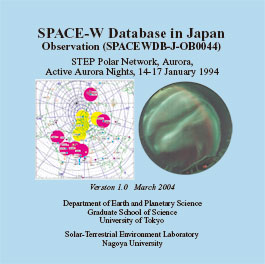Database in Japan
Observation (SPACEW-J-OB0044)
Version 1.0 March 2004
(CAWSES database in Japan)
STEP Polar Network, Aurora, Active Aurora Nights, 14-17 January 1994

OB0044
| SPACE-W (Space Weather International Collaborative Research) Database in Japan Observation (SPACEW-J-OB0044) Version 1.0 March 2004 (CAWSES database in Japan) STEP Polar Network, Aurora, Active Aurora Nights, 14-17 January 1994 |
 OB0044 |
We are pleased to release copies of auroral data in DVD-ROM of the original time resolution on the best sample of successive four nights with active auroras and clear night-sky from data acquired at Dawson City Yukon, Canada during one of the campaign observations operated as a part of the STEP Polar Network program by University of Tokyo.
1. Observation, instruments and operation
Location: The Dome 2 (64.26N,221.4E) at an elevation of 1070m and 10km north of Dawson City, Yukon, Canada
Housing: There is a lookout tower for finding forest fires at the top of Dome 2. A standby cabin for watching fires in summer season was lived year through by a forestry staff.
Observation campaign period: January 05-January 21, 1994
Instruments: An all-sky imager system taking panchromatic pictures every 1/4 second
The part of camera system (A) was set and operated in open air typically of about minus 30 degrees Celsius. The recorder system (B) was operated in the cabin at room temperature.
A. - A NIKON 8 mm fish-eye lens for 35mm cameras
- A relay lens shrinking images down to 66% size.
- An image intensifier (Night Viewer by Hamamatsu Photonics Co.)
- A CCD Camera (Hamamatsu Photonics Co.)
B. - A time lapse video cassette recorder (8mm, 4 frames/sec, SONY Co.)
Electric power: 2KW generator (Honda)
Logistic and accommodation support: Bill Jackson, Forestry Department of Yukon Territory
Observation operation: Kanji Hayashi, University of Tokyo
2. Contents of a DVD-ROM
Video data of full four nights, 53 hours, are copied in four sections of one DVD-ROM with titles of "940114", "940115", "940116", and "940117". Chapter positions at every UT hour are selectable within a tile by quick jump operations. Play back data rate is same to the standard video rate of 30 frame par second. Movie pictures displayed on a screen advances 7.5 times faster than real time motion because the original data was recorded by a quarter second rate.
1. "940114"
Start 2:24 UT (18:24 PST )
Chapters 03:00, 04:00, 05:00, 06:00, 07:00,08:00, 09:00
10:00, 11:00, 12:00, 13:00, 14:00, 15:00, 16:00
End 16:16
2. "940115"
Start 02:42UT ( 18:42 PST )
Chapters 03:00, 04:00, 05:00, 06:00, 07:00, 08:00, 09:00
10:00, 11:00, 12:00, 13:00, 14:00, 15:00, 16:00
End 16:02 (Data in the last two hours is contaminated by noise.)
3. “940116”
Start 02:54UT ( 18:54 PST )
Chapters 03:00, 04:00, 05:00, 06:00, 07:00, 08:00, 09:00
10:00, 11:00, 12:00, 13:00, 14:00, 15:00, 16:00
End 16:20
4. "940117"
Start 03:11UT ( 19:11 PST )
Chapters 04:00, 05:00, 06:00, 07:00, 08:00, 09:00
10:00, 11:00,12:00, 13:00, 14:00, 15:00, 16:00
End 16:20
3. Encoding format of data
In this DVD-ROM disk video data of net 7 hours in the original tapes were converted and recorded with keeping a MPEG2 quality by using "XVD plus"TM software (B.H.A Corporation, http://www.bha.co.jp/).
A DVD-ROM is automatically played back when the DVD-ROM disk is loaded into a DVD disk player working on a personal computer running under Microsoft Windows.
Please refer the “readme-XVD.txt” file in the DVD-ROM on the system requirements that must be filled by your computer. The control panel of the play back software "XVD Player" TM is ease to use looking like an ordinary video player displayed on a computer screen. Selection of a title from in the above mentioned lists, however, is only available in a menu that appears by a click of the right button of your mice.
4. Fidelity of data after encoding and decoding
The history listed below of data conversions must be taken into account if one would use the DVD-ROM data for quantitative analyses.
0. Original analog data in video cassette tapes of 8mm type
1. Digitization and encoding from analog data to MPEG2 data
2. XVD encoding from MPEG2
Acknowledgments;
The observation campaign program was supported by grants in aid from Ministry of Education, Science, and Culture.
We highly appreciate Bill Jackson who provided us opportunities for the successive seven seasons since 1994 to enable us observation at the top of Dome2 where is excellent not only both in the field of view and free from fogy air but also for his perfect supports with nice meals and for transportation by driving his skidoo to carry up instruments and daily supplies of fuels, water and foods.
CONTACTS
Principal Investigator
Dr. Kanji Hayashi, retired in 2003
Department of Earth and Planetary Science
Graduate School of Science
University of Tokyo
7-3-1 Hongo, Bunkyoku, Tokyo 113-0033, Japan
E-mail: hayashi[AT]eps.s.u-tokyo.ac.jp